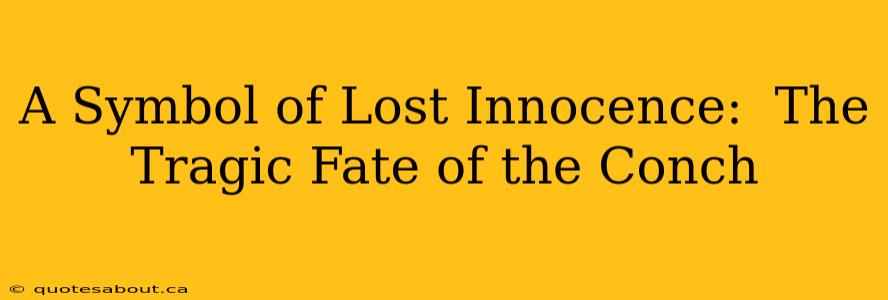The conch shell in William Golding's Lord of the Flies is far more than just a beautiful seashell; it's a potent symbol representing order, civilization, and most tragically, lost innocence. Its journey throughout the novel mirrors the boys' descent into savagery, making it a powerful literary device that continues to resonate with readers decades later. This exploration delves into the conch's significance, examining its symbolic weight and its ultimate demise.
What does the conch symbolize in Lord of the Flies?
The conch initially embodies the boys' hope for rescue and their attempt to establish a civilized society on the deserted island. Its discovery signifies the potential for order and democracy, as its sound summons meetings and allows for rational discussion and decision-making. Ralph, the elected leader, holds the conch, wielding its power to maintain a semblance of control and civility amongst the stranded boys. The conch's very existence represents the boys' clinging to their former lives and the values instilled in them by their civilized upbringing.
How does the conch's symbolism change throughout the novel?
As the boys' descent into savagery progresses, the conch's symbolic power begins to wane. As Jack and his tribe gain influence, their disregard for the conch's authority becomes increasingly apparent. The conch's power is intrinsically linked to the boys' adherence to democratic principles and respect for rational discourse – principles that gradually erode as fear, tribalism, and primal instincts take hold. The conch's weakening authority mirrors the unraveling of their civilized society.
Why is the conch's destruction such a significant moment?
The brutal destruction of the conch represents the complete loss of hope, reason, and order. Piggy's death, coinciding with the conch's shattering, is a pivotal moment, highlighting the irrevocable loss of innocence and the triumph of savagery. The conch, once a symbol of hope and civilization, is reduced to fragments, mirroring the shattered remnants of the boys' former selves. This act signifies a total abandonment of rational thought and societal norms, leaving only primal instincts and chaos.
What happens to the conch at the end of the book?
The conch is deliberately smashed by Roger, a symbol of the unchecked violence and savagery that has overtaken the boys. This act of destruction is not accidental; it's a deliberate and violent rejection of order and reason. The shattering of the conch marks the final extinction of the boys' hope for rescue and their complete surrender to the dark impulses within them.
What does the destruction of the conch symbolize?
The destruction of the conch symbolizes the complete and utter collapse of civilization and the triumph of savagery over reason. It marks the point of no return, where the boys have fully embraced their primal instincts, abandoning all vestiges of their former lives and the values they once held dear. It signifies a tragic loss of innocence and the terrifying potential for darkness that lies within human nature.
What are the different interpretations of the conch's symbolism?
The symbolism of the conch is multifaceted and open to interpretation. While it primarily represents order, civilization, and innocence, some might view it as a symbol of imposed authority or the limitations of rational thought in the face of primal urges. The ambiguity of the conch's symbolism adds to its enduring power and continues to spark debate and discussion amongst readers.
The conch's journey in Lord of the Flies serves as a poignant allegory for the fragility of civilization and the ever-present threat of savagery. Its tragic fate remains a powerful reminder of the importance of reason, order, and the fight against the darker aspects of human nature.

